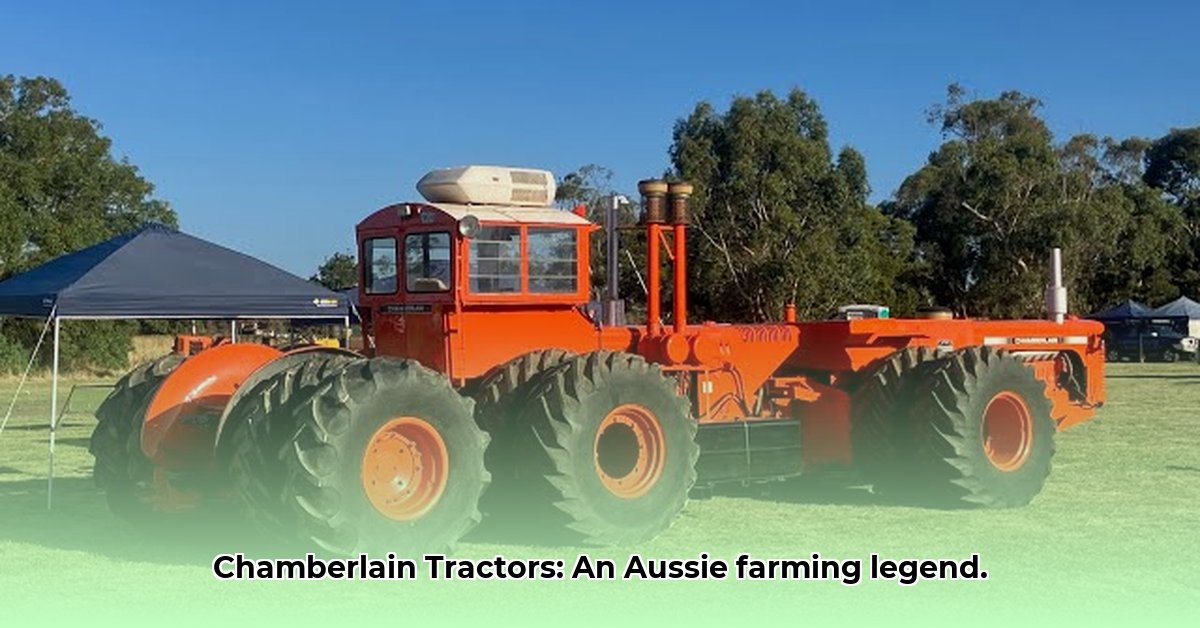
The sun-baked plains of the Australian outback hummed for decades to the rhythmic chug of Chamberlain tractors. More than mere machines, these tractors were integral to the nation's agricultural story, shaping farming practices and becoming iconic symbols of Australian ingenuity. This isn't a technical manual; rather, it's a narrative exploring their rise, fall, and lasting legacy – a story of innovation, resilience, and the enduring impact on Australian agriculture and sustainable farming practices.
A Partnership Forged in the Outback
Chamberlain tractors weren't born in isolation. Their emergence stemmed from a strategic alliance—a collaboration blending Australian resourcefulness with John Deere's global expertise. This partnership was crucial; it aimed to create world-class farming equipment specifically designed for the unique challenges of the Australian landscape: vast distances, unpredictable weather, and demanding terrains. Models like the Sedan 80 and 90 series became synonymous with reliability, earning a reputation for tackling the toughest jobs with unwavering determination. They weren't just tractors; they were partners to generations of Australian farmers. How many hours did these machines tirelessly toil across sun-drenched paddocks, contributing to the nation's food security?
The robust build and powerful engines of Chamberlain tractors became legendary. They were built to last, designed to withstand years of relentless work under often harsh conditions. This durability is a key element of their lasting impact. Farmers relied on their dependability, often performing maintenance and repairs themselves, fostering a deep connection between farmer and machine. Did this relationship between familiarity and reliability contribute to a more sustainable approach to farming in its time?
More Than Just Machines: A Legacy Etched in the Dust
Chamberlain tractors weren't simply pieces of equipment; they represented a significant part of the Australian identity, becoming symbols of national pride and agricultural prowess. Imagine the feeling of pride a farmer experienced, skillfully maneuvering their Chamberlain across their land, a powerful machine reflecting their efforts and the ingenuity of its creators. The rhythmic chug of their engines became the soundtrack to countless days spent cultivating the land. What better representation of the symbiotic relationship between man and machine in shaping the nation's agricultural landscape?
However, even the strongest legacies eventually come to an end. By 1986, Chamberlain tractor production ceased. The reasons behind this are complex and multifaceted, involving shifting economic forces, global market pressures, and strategic decisions that didn't yield the desired results. Historians and agricultural economists continue to debate the exact contributing factors. What factors contributed most significantly to the cessation of Chamberlain tractor production? This question remains a subject of ongoing scholarly debate.
Ghosts in the Paddocks: An Enduring Presence
Despite the end of production, Chamberlain tractors refuse to fade into obscurity. Many continue to operate across the country, some painstakingly restored, others proudly bearing the scars of years of service. These aren't mere antiques; they're living testaments to superior durability and Australian ingenuity. Their continued presence raises important questions: were these tractors ahead of their time? Was their decline a missed opportunity for greater Australian agricultural independence? What lessons can we learn from their story for building more resilient future industries?
The persistence of Chamberlain tractors highlights their enduring impact. Their exceptional robustness provides invaluable insights for modern agricultural practices. The machines' remarkable longevity and the continued demand for parts and repairs suggest a need for more durable and long-lasting agricultural equipment. How can we create more sustainable agricultural technologies inspired by the resilience of the Chamberlain legacy?
A Modern Lesson: Sustainability and Self-Sufficiency
The end of Chamberlain tractor production offers valuable lessons for contemporary sustainable agriculture and resilient supply chains. The increasing dependence on imported machinery reveals the vulnerabilities of relying solely on foreign sources for critical agricultural equipment. Consider the implications of sourcing parts, repair services, and supply chain stability. What happens when a vital component breaks down on an imported tractor, and replacement takes weeks or months? The environmental impact of transporting heavy machinery long distances also raises serious concerns. Could a renewed focus on local manufacturing lead to greater environmental sustainability and agricultural resilience?
While comprehensive data on the environmental footprint of Chamberlain tractors is lacking—such as fuel efficiency compared to modern models—further research into this area is crucial. Preliminary evidence suggests that a careful comparison of fuel consumption, emissions, and lifespan could reveal valuable insights into their environmental legacy. Their story underscores the importance of investigating the environmental impact of agricultural technologies across their life cycle.
Remembering the Past, Building the Future
The narrative of Chamberlain tractors transcends simple nostalgia. It serves as a powerful reminder of Australia's industrial capacity, a testament to human ingenuity, and a compelling lesson in building resilient, localized industries. Their story demands continued investigation to fully understand their impact on Australian agriculture. This legacy underscores the significance of supporting local industries, fostering innovation, and ensuring a secure and sustainable future for Australian agriculture. The story of Chamberlain tractors is a valuable case study – a powerful testament to a bygone era, yet with lasting relevance in today’s world.